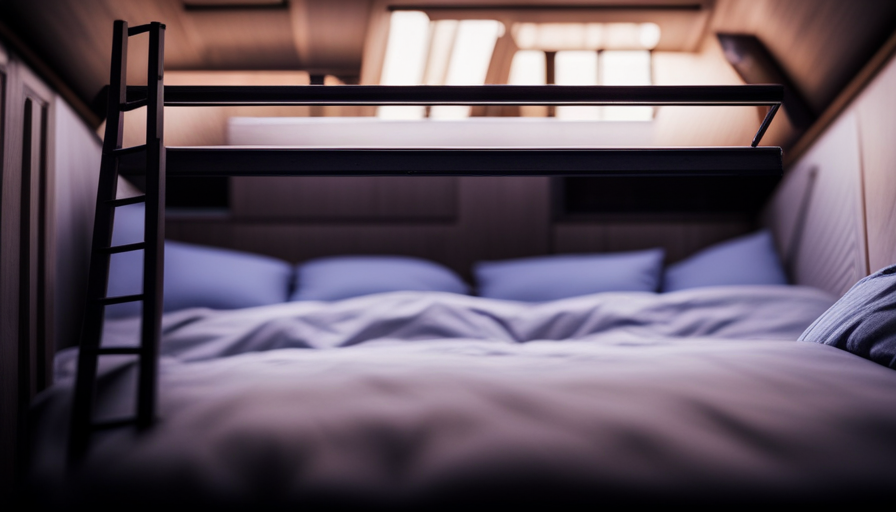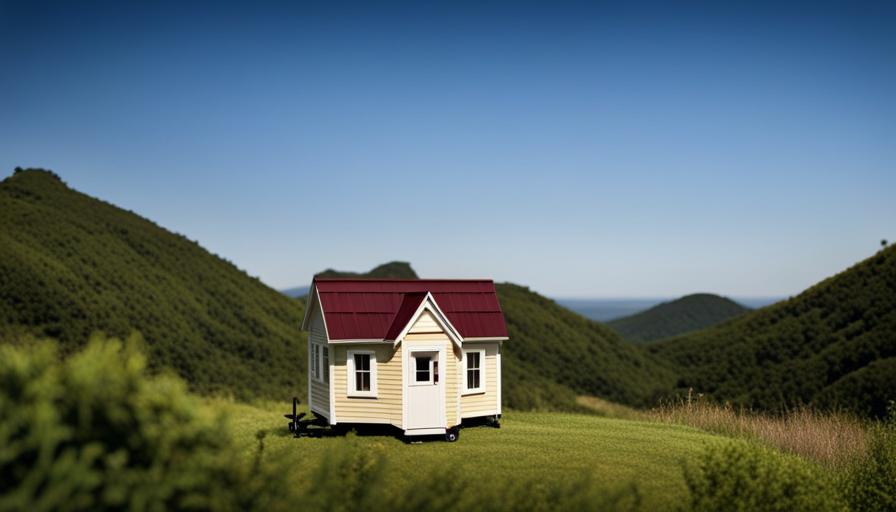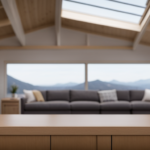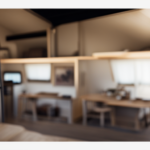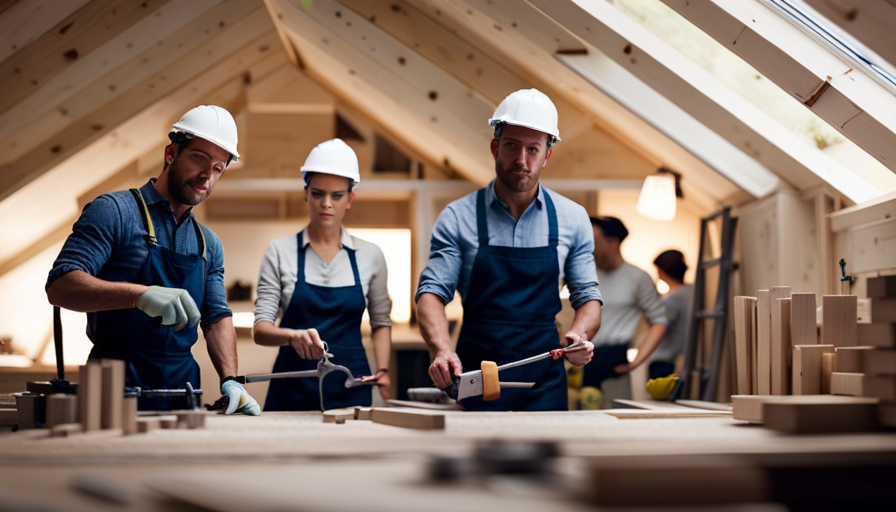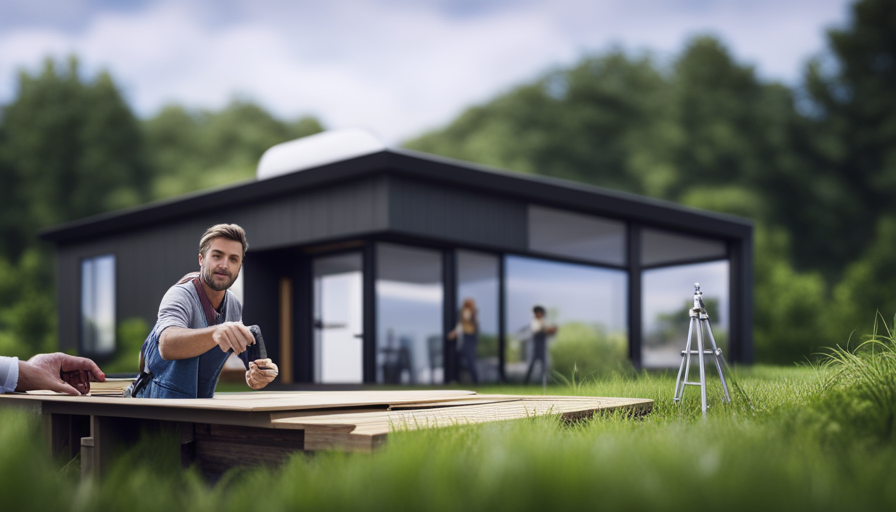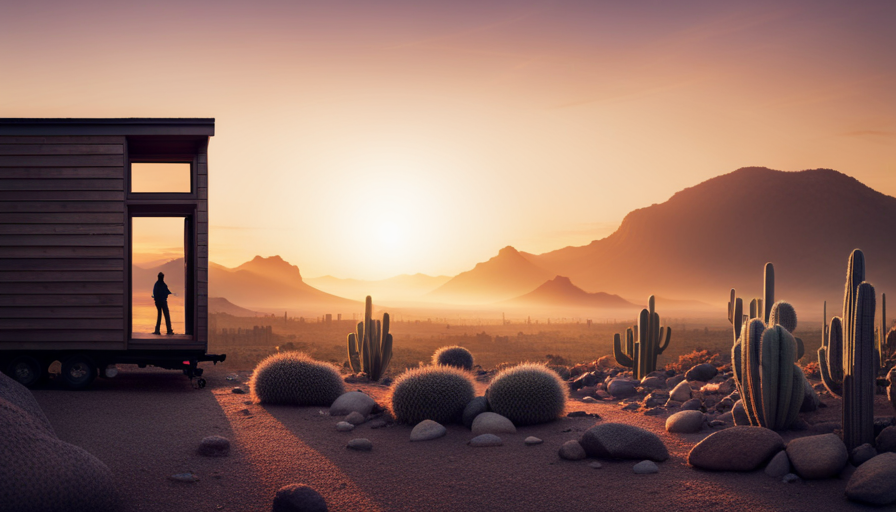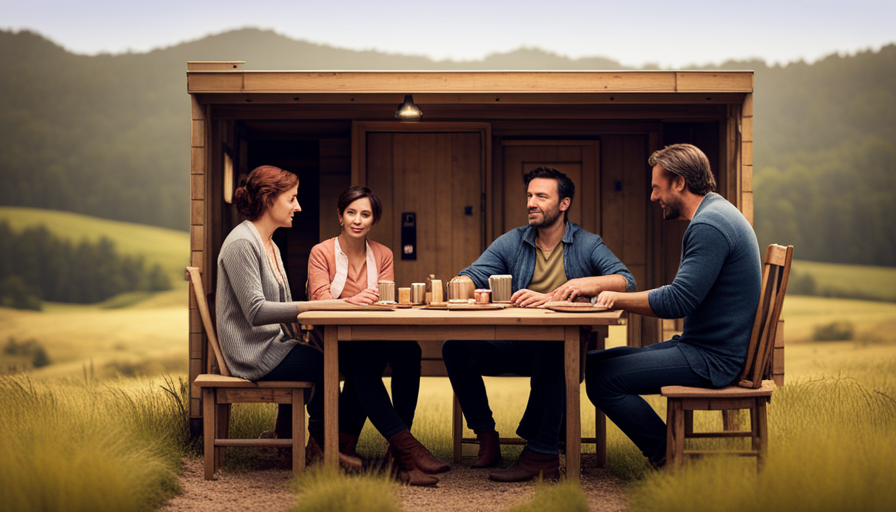Were you aware that the mean stature of an individual in the United States measures at 5 feet 9 inches? This is a fascinating figure to bear in mind while designing the loft height in a tiny home.
Hi, I’m here to guide you through the process of determining the ideal height for your tiny house loft. As a tiny house enthusiast myself, I understand the importance of maximizing space and creating a comfortable living environment.
In this article, we will explore various factors to consider when deciding how high your tiny house loft should be. From headroom needs to furniture requirements, sleeping space preferences to safety regulations and codes, we will cover it all.
We will also delve into the world of tiny house builders and designers for inspiration and advice. So, let’s dive in and start designing the perfect loft for your tiny house!
Key Takeaways
- Loft height in a tiny house should balance functionality and design, considering factors such as personal preferences, furniture requirements, and overall aesthetic.
- Safety regulations and codes, including minimum headroom requirements and staircase dimensions, must be followed when determining the loft height.
- Accessibility needs and mobility challenges should be taken into account when designing the loft, incorporating features like adjustable elements, wide pathways, and ample lighting.
- Seeking inspiration and advice from professionals in tiny house construction and design can help maximize vertical space and ensure compliance with regulations.
Consider Your Headroom Needs
If you’re wondering how high your tiny house loft should be, it’s important to consider your headroom needs. Make sure you’ll have enough space to stand up comfortably. When designing your loft, take into account the headroom requirements that will allow you to move around without feeling cramped.
A standard height for a tiny house loft is around 3-4 feet, but this may vary depending on your personal preferences and lifestyle.
To determine your ideal loft height, consider factors such as your height, mobility, and how you plan to use the space. If you’re tall or have mobility issues, you may want to opt for a higher loft to ensure ease of movement. Additionally, if you plan to use your loft for activities other than sleeping, such as working or exercising, you may want to consider a higher ceiling to accommodate additional furniture or equipment.
Design considerations for your loft height include the placement of windows and the overall aesthetic of your tiny house. Higher ceilings can create a more open and spacious feel, while lower ceilings can provide a cozy and intimate atmosphere. It’s important to strike a balance between functionality and design.
As you evaluate your headroom requirements, it’s also essential to think about your furniture needs. Ensure that your loft is tall enough to accommodate your furniture, creating a comfortable and functional living space.
Evaluate Your Furniture Requirements
When designing the layout of my tiny house loft, one key factor I need to consider is the height of my furniture. I’ll need to measure the height of each piece I plan to place in the loft to ensure it’ll fit comfortably without hitting the ceiling.
Additionally, I’ll need to make sure there’s enough clearance above the furniture to avoid feeling cramped and claustrophobic.
By taking these measurements and considerations into account, I can create a functional and comfortable living space within my tiny house loft.
Measure the height of any furniture pieces you plan to place in the loft
Ensure you measure the height of all furniture pieces you intend to place in the loft, so you don’t encounter any unexpected surprises.
When determining the headroom requirements for your tiny house loft, it’s crucial to consider the height of your furniture. Measure the tallest furniture items, such as beds, sofas, and cabinets, to ensure they’ll fit comfortably in the space without compromising headroom. This step is essential because inadequate headroom can make the loft feel cramped and uncomfortable.
Additionally, it’s crucial to consider furniture clearance when measuring the height. Allow enough space above the furniture to ensure easy movement and accessibility.
By taking these measurements into account, you can ensure there’s enough clearance above the furniture to avoid feeling cramped and restricted in your tiny house loft.
Ensure there is enough clearance above the furniture to avoid feeling cramped
Make sure there’s ample space above your furniture to prevent a cramped and restricted feeling in the loft. When designing a tiny house loft, maximizing space is crucial, but it shouldn’t ever come at the expense of comfort. You want your loft to feel open and airy, not claustrophobic.
Measure the height of your furniture pieces and take into account any decorative elements or lighting fixtures that may hang from the ceiling. Ensure that there’s enough clearance above the furniture to avoid feeling cramped. This’ll also allow for easy movement and prevent any accidents or injuries.
By designing for comfort and considering the height of your furniture, you can create a loft that’s both functional and inviting.
Transitioning into the next section, it’s important to determine your sleeping space preferences.
Determine Your Sleeping Space Preferences
When it comes to determining my sleeping space preferences, I have to decide whether I prefer a cozy, low-height sleeping area or a more spacious loft.
Both options have their own advantages and disadvantages, so I need to carefully consider what will work best for me in terms of comfort and functionality.
Additionally, I should think about any specific design features or functionality that I want in my sleeping space, such as built-in storage or easy access to natural light.
Decide whether you prefer a cozy, low-height sleeping area or a more spacious loft
If you’re someone who loves the feeling of being nestled in a cozy sleeping area, a low-height loft in your tiny house might be just the perfect retreat for you. Imagine climbing up a ladder or stairs and entering a snug space where you can curl up and feel completely enveloped by your surroundings. A low-height loft offers a sense of intimacy and security that can be incredibly comforting.
On the other hand, if you prefer a more spacious sleeping area where you can stretch out and move around freely, a higher loft might be more suitable for you. With a larger loft, you can incorporate additional design features such as a sitting area, storage compartments, or even a mini office space. Consider any specific design features or functionality you want in your sleeping space, whether it’s a cozy nook or a more open and versatile loft.
Now let’s explore the next aspect of designing your perfect tiny house sleeping space.
Consider any specific design features or functionality you want in your sleeping space
Think about what specific design features or functionality you want in your cozy sleeping nook or spacious loft. When considering design considerations, it’s important to think about space utilization and how to make the most of the limited area in a tiny house.
Here are some ideas to consider:
-
Multi-functional furniture: Look for pieces that serve multiple purposes, such as a bed with built-in storage or a desk that can be folded away when not in use.
-
Clever storage solutions: Maximize vertical space by incorporating shelves or cabinets that go all the way up to the ceiling. Utilize under-bed storage or hidden compartments to keep your sleeping area clutter-free.
-
Natural light: Consider adding skylights or large windows to bring in as much natural light as possible, making the space feel more open and airy.
When designing your sleeping space, keep in mind these design considerations and how they can enhance the functionality and aesthetics of your tiny house.
Next, we will delve into the topic of factor in safety regulations and codes.
Factor in Safety Regulations and Codes
When considering the height of my tiny house loft, I need to factor in safety regulations and codes. It’s crucial to research the building codes and regulations in my area to ensure I comply with the necessary requirements.
By doing so, I can ensure that my tiny house loft meets the necessary safety standards and provides a secure living space.
Research the building codes and regulations in your area regarding loft height
Researching the building codes and regulations in your area will help you determine the acceptable height for a loft in a tiny house. It’s important to consider headroom requirements and safety standards when designing your loft. Here are three key factors to consider:
-
Minimum Headroom: Building codes typically require a minimum headroom clearance of 6 feet 8 inches in habitable spaces. This ensures that occupants can comfortably stand and move around without hitting their heads.
-
Staircase Dimensions: The height and width of the staircase leading to the loft must meet specific requirements to ensure safe and easy access. These dimensions may vary depending on your local building codes.
-
Railing Height: The height of the railing surrounding the loft is crucial for preventing falls. Most regulations require a minimum height of 36 inches to provide adequate protection.
By researching and adhering to these building codes and regulations, you can ensure your tiny house loft meets the necessary safety standards and requirements without compromising on design or functionality.
Ensure your tiny house loft meets the necessary safety standards and requirements
To guarantee compliance with safety standards and regulations, make sure your loft in the compact dwelling abides by the necessary requirements and standards. Headroom considerations and loft safety measures are crucial factors to address when designing your tiny house loft. Ensuring sufficient headroom is essential to prevent injuries and provide a comfortable living space. Additionally, implementing safety measures such as sturdy railings and secure ladders or stairs is vital to prevent accidents and promote accessibility. To further engage you in this topic, let’s take a look at the table below, which outlines the recommended headroom and safety standards for tiny house lofts:
| Headroom Requirements | Safety Measures |
|---|---|
| Minimum 6 feet | Sturdy railings |
| Secure ladders | |
| or stairs |
Now that we have covered the necessary safety considerations, let’s move on to the next section about planning for accessibility and mobility within your tiny house design.
Plan for Accessibility and Mobility
When planning for accessibility and mobility in a tiny house, it’s crucial to consider any specific accessibility needs that may arise. For instance, one should take into account the ability to climb up and down the loft area and ensure that it’s designed in a way that accommodates any mobility challenges or potential changes in mobility in the future.
By incorporating these considerations into the design process, one can create a loft that’s not only functional but also accessible and adaptable for individuals with various abilities.
Consider any accessibility needs, such as the ability to climb up and down the loft
Considering any accessibility needs, such as the ability to climb up and down the loft, it’s fascinating to note that approximately 1 in 4 adults in the United States experience some form of mobility limitation, highlighting the importance of designing a tiny house loft that caters to a wide range of individuals.
| Climbing Safety | Accessibility Modifications | Future Mobility Changes |
|---|---|---|
| Sturdy handrails | Adjustable ladder or stairs | Flexibility in design |
| Non-slip steps | Wide and well-lit stairs | Incorporating a lift |
| Secure footholds | Clear pathways | Space for assistive devices |
| Proper lighting | Grab bars | Adaptable furniture |
| Emergency exit plan | Braille or tactile signs | Open floor plan for easy navigation |
Creating a loft that prioritizes climbing safety and accessibility modifications is crucial. Sturdy handrails, non-slip steps, secure footholds, and proper lighting all contribute to a safe and comfortable ascent and descent. Incorporating a lift or an adjustable ladder/stairs can accommodate individuals with different mobility levels. It’s essential to design your loft to accommodate any mobility challenges or future changes in mobility, ensuring a functional and inclusive space for all occupants.
Design your loft to accommodate any mobility challenges or future changes in mobility
Ensure that your loft is thoughtfully designed to meet the needs of individuals with mobility challenges or potential future changes in mobility. When designing for aging, accessibility, and mobility, consider the following:
-
Adjustable features: Install adjustable handrails and grab bars that can be easily modified to accommodate different heights and needs. This allows for flexibility as mobility requirements change over time.
-
Wide and smooth pathways: Create wide and smooth pathways within the loft to ensure easy maneuverability for individuals with mobility aids such as walkers or wheelchairs. Avoid any obstacles or sharp turns that may hinder movement.
-
Ample lighting: Incorporate ample lighting throughout the loft to enhance visibility and reduce the risk of accidents. Proper lighting can also help individuals with vision impairments navigate the space more easily.
By incorporating these design elements, you can create a loft that promotes accessibility and mobility for individuals with different needs.
Transitioning into the subsequent section about maximizing vertical space, it’s crucial to consider the efficient utilization of every inch of your tiny house.
Maximize Vertical Space
To make the most of vertical space in a tiny house loft, you can use clever storage solutions and multi-functional furniture. Maximizing space in a small area requires utilizing verticality effectively.
One option is to install built-in shelves and cabinets that extend all the way up to the ceiling. This not only provides ample storage for your belongings but also draws the eye upward, creating an illusion of a larger space.
Another way to maximize vertical space is by incorporating lofted beds or platforms. By elevating the sleeping area, you can free up valuable floor space for other activities.
Additionally, consider using furniture that serves dual purposes, such as a sofa that can transform into a bed or a coffee table with built-in storage compartments. These space-saving solutions help to optimize every inch of your tiny house loft.
To seek inspiration from tiny house builders and designers, I explored various websites and attended tiny house expos. These experiences exposed me to innovative design ideas and allowed me to adapt them to suit my specific needs.
Seek Inspiration from Tiny House Builders and Designers
When it comes to maximizing vertical space in a tiny house loft, I find it incredibly helpful to seek inspiration from tiny house builders and designers.
By looking at examples of lofts in similar-sized homes or designs, I can get a better idea of what’s possible and what might work best for my own space.
Additionally, professionals who specialize in tiny house construction and design can offer valuable ideas and inspiration that I may not have considered on my own.
With their expertise, I can create a loft that’s not only functional but also aesthetically pleasing and uniquely tailored to my needs.
Look for examples of tiny house lofts in similar-sized homes or designs
Check out some examples of tiny house lofts in similar-sized homes or designs, so you can get an idea of how high to build yours. When designing your tiny house loft, it’s important to consider furniture arrangement and safety considerations. To help you visualize different possibilities, I have created a table showcasing four examples of tiny house lofts:
| Example | Loft Height (feet) |
|---|---|
| 1 | 5 |
| 2 | 6 |
| 3 | 7 |
| 4 | 8 |
These examples demonstrate different loft heights that you can consider for your own tiny house. Remember, the height of your loft should allow for comfortable movement and provide adequate headroom. Once you have an idea of the loft height you prefer, you can move on to the next step of getting ideas and inspiration from professionals who specialize in tiny house construction and design.
Get ideas and inspiration from professionals who specialize in tiny house construction and design
Seeking input and inspiration from experts in the field of building and designing small dwellings can provide a wealth of creative ideas to fuel your own tiny home project. When it comes to designing a tiny house loft, it’s important to consider headroom requirements and safety regulations.
Professionals in tiny house construction and design can offer valuable insights and expertise on these matters. They can provide guidance on how to maximize headroom without compromising structural integrity. Additionally, they can advise on safety regulations and help ensure that your loft meets all necessary standards.
By consulting with these professionals, you can gain a deeper understanding of the technical aspects involved in designing a tiny house loft. With their expertise, you can confidently test and adjust your design to create the perfect space for your tiny home project.
Test and Adjust Your Design
When it comes to designing a tiny house loft, it’s crucial to test and adjust your design to find the perfect height.
One effective way to do this is by building a mock-up or utilizing a virtual design tool.
By experimenting with different loft heights, I was able to determine the optimal height that suited my personal preferences and needs.
After making adjustments based on my findings, I was able to finalize my design with confidence and ensure it would meet my requirements.
Build a mock-up or use a virtual design tool to test different loft heights
To get a better sense of how high you want your tiny house loft to be, why not create a mock-up or try out a virtual design tool to test out different heights? This will give you a visual representation of what the loft will look like and help you make adjustments based on your personal preferences and needs before finalizing your design. Virtual design tools offer several advantages, such as the ability to easily adjust the height, width, and length of the loft, as well as the option to view it from different angles. However, virtual design tools have their limitations, as they cannot provide the same level of tactile feedback as a physical mock-up. By using a mock-up or virtual design tool, you can confidently determine the perfect height for your tiny house loft.
| Height (inches) | Pros | Cons |
|---|---|---|
| 48 | Easy access | Limited headroom |
| 60 | Sufficient headroom | Less living space |
| 72 | Spacious | Difficult to climb |
| 84 | Maximum headroom | Limited floor space |
| 96 | Room for storage | Challenging to build |
Now that you have a better understanding of loft heights, you can make adjustments based on your personal preferences and needs before finalizing your design.
Make adjustments based on your personal preferences and needs before finalizing your design
Before you wrap up your design, take a moment to tailor it to your unique tastes and requirements, ensuring that your tiny haven is perfectly suited to you. Consider your headroom requirements and the measurements of any furniture you plan to include in your tiny house loft.
Measure the height of your loft space and compare it to the height of your furniture to ensure that you have enough headroom for comfortable movement. You may want to adjust the height of the loft to accommodate taller furniture or to create a more open and spacious feel.
Additionally, think about any specific needs or preferences you have, such as the ability to stand up straight in your loft or the desire for a cozy, low-ceilinged space. By making these adjustments, you can create a loft that is both functional and comfortable.
As you consider future needs and flexibility, keep in mind that your tiny house may need to adapt to changes in your lifestyle or living situation.
Consider Future Needs and Flexibility
When considering the height of my tiny house loft, I must think about how it may need to adapt to potential changes in my lifestyle or living situation.
I need to plan for future modifications or adjustments to ensure that my loft remains functional over time. By being proactive and considering my future needs and flexibility, I can create a design that will accommodate any changes that may arise in my living situation.
Think about how your loft height may need to adapt to potential changes in your lifestyle or living situation
Consider how the height of your tiny house loft might need to adjust to accommodate any future changes in your lifestyle or living arrangements.
When designing your loft, it’s important to think about the headroom requirements and furniture dimensions that may be necessary in the future. For example, if you plan on adding a desk or a larger bed, you’ll need to ensure that there’s enough clearance space above.
Additionally, if you anticipate any physical limitations or mobility issues in the future, you may want to consider a higher loft to allow for easier movement.
By considering these factors now, you can plan for future modifications or adjustments to ensure your tiny house loft remains functional over time. This’ll save you from having to make costly changes later on.
Moving forward, let’s explore how to plan for these modifications.
Plan for future modifications or adjustments to ensure your tiny house loft remains functional over time
To ensure your tiny oasis evolves with your changing needs and desires, think ahead and strategize for future adjustments or modifications that will keep your loft a functional and inviting space. Here are four key considerations to help you plan for future modifications and ensure the functionality of your tiny house loft over time:
-
Flexibility: Design your loft with adjustable features, such as removable partitions or foldable furniture, to accommodate changing lifestyles or living situations.
-
Storage Solutions: Incorporate ample storage options into your loft design to accommodate future belongings and prevent clutter from taking over your limited space.
-
Accessibility: Plan for future accessibility needs by considering wider doorways, ramps, or even an elevator system that can be added later if necessary.
-
Technological Upgrades: Stay ahead of the curve by incorporating smart home technology into your loft design, allowing for easy integration of future upgrades and advancements.
By planning for future modifications and ensuring functionality over time, your tiny house loft can continue to adapt and meet your evolving needs. Seek professional advice if needed to ensure your plans align with building codes and regulations.
Seek Professional Advice if Needed
If you’re unsure about the height of your tiny house loft, it’s always a good idea to consult with a professional for expert advice. Accessibility considerations are crucial when determining the height of your loft. You want to ensure that it is easily accessible and safe for you and any potential guests.
A professional can help you assess the layout of your tiny house and provide recommendations on the ideal loft height to meet your specific needs.
In addition to accessibility, loft height regulations should also be taken into account. Depending on where you plan to park or build your tiny house, there may be local regulations or building codes that dictate the maximum height allowed for lofts. By seeking professional advice, you can ensure that your loft complies with these regulations and avoid any potential legal issues in the future.
A professional can also provide guidance on any future modifications or adjustments that may be necessary to maintain the functionality of your tiny house loft over time. They can help you anticipate any potential challenges or limitations and offer creative solutions to overcome them. With their technical expertise, they can ensure that your loft remains a functional and comfortable space for years to come.
Seeking professional advice is essential when determining the height of your tiny house loft. They can help you consider accessibility considerations, loft height regulations, and plan for future modifications or adjustments to ensure that your loft remains functional and compliant with building codes.
Frequently Asked Questions
What are some creative ways to maximize vertical space in a tiny house loft?
To maximize vertical space in a tiny house loft, innovative loft designs can be employed. One creative way is to utilize built-in storage solutions such as shelving units or cabinets that extend up to the ceiling.
Another option is to incorporate multi-functional furniture, like a loft bed with a desk or seating area underneath.
Additionally, utilizing vertical wall space for hanging storage or installing a loft ladder that folds up when not in use can also help optimize the space in a tiny house loft.
Are there any safety regulations or codes that need to be considered when building a tiny house loft?
When considering the construction of a tiny house loft, it’s crucial to prioritize safety requirements and adhere to construction guidelines. These regulations and codes ensure the structural integrity and well-being of the occupants. Factors such as maximum height, minimum headspace, and proper access must be carefully considered.
By following these guidelines, one can create a loft that not only maximizes vertical space but also provides a secure and comfortable living environment.
How can I ensure that my tiny house loft is accessible and provides mobility options?
To ensure an accessible design and provide mobility options for your tiny house loft, there are a few key considerations.
Firstly, you should incorporate features such as wider doorways and ramps for wheelchair accessibility.
Additionally, installing a stair lift or a compact elevator can greatly enhance mobility within the loft.
It’s also important to consider the placement and design of furniture and fixtures to allow for easy maneuverability.
By prioritizing these elements, you can create a loft that promotes independence and inclusivity.
What are some common mistakes to avoid when designing a tiny house loft?
When designing a tiny house loft, it’s crucial to avoid common mistakes that can compromise functionality and comfort. To maximize vertical space, consider incorporating creative ways, such as built-in storage or multi-functional furniture.
One mistake to avoid is not taking into account the headroom needed for comfortable movement within the loft. Additionally, failing to properly insulate the loft can lead to temperature regulation issues.
By carefully considering these design aspects, you can create a tiny house loft that’s both functional and visually appealing.
Is it possible to make adjustments to the loft design after it has been built?
Yes, it’s possible to make adjustments to the loft design after it’s been built. One can easily modify the height, width, or length of the loft to better suit their needs. Additionally, modifying the loft layout is also achievable. This can be done by rearranging the furniture, adding or removing partitions, or even changing the location of windows or doors. These adjustments allow for a more flexible and personalized living space within the tiny house.
Conclusion
As I stood in the empty space of my tiny house loft, I couldn’t help but feel a sense of excitement and anticipation. The possibilities were endless, and the decisions I had made regarding headroom, furniture requirements, sleeping space, safety regulations, accessibility, and mobility were all coming together.
It was time to put my plan into action and see the vision in my mind become a reality. The journey had been long, but the destination was within reach. With each step, the suspense grew, and I knew that the final result would be nothing short of extraordinary.
Hi, I’m Emma. I’m the Editor in Chief of Tiny House 43, a blog all about tiny houses. While tree houses are often associated with childhood, they can be the perfect adult retreat. They offer a cozy space to relax and unwind, surrounded by nature. And since they’re typically built on stilts or raised platforms, they offer stunning views that traditional homes simply can’t match. If you’re looking for a unique and romantic getaway, a tree house tiny house might just be the perfect option.
